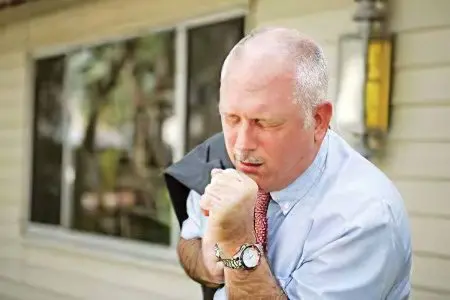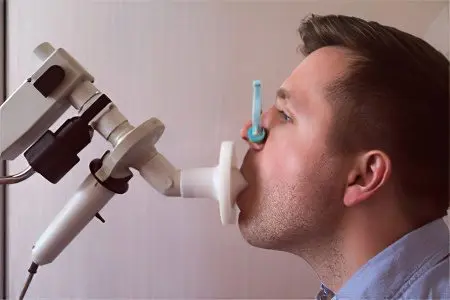Contents
Shortness of breath is a violation of the frequency of the rhythm, as well as the depth of breathing. At the same time, a person experiences a feeling of lack of air, it is difficult for him to breathe deeply. Doctors distinguish between subjective and objective shortness of breath.
What is subjective dyspnea?

Subjective shortness of breath It manifests itself in the fact that a person experiences difficulties with breathing, but at the same time there are no objective signs of a change in its depth, rhythm and frequency.
Subjective shortness of breath may be accompanied by neurosis, neurocirculatory asthenia and hysterical seizures. Another such shortness of breath is called respiratory neurosis. It has been proven that about 80% of patients suffering from neurosis and hysteria periodically experience changes in the respiratory rhythm.
The human respiratory system is controlled by the brain. Violations in the functioning of the nervous system, stress and hysteria – all this leads to malfunctions in the work of a single well-coordinated mechanism. The respiratory center begins to send too frequent nerve impulses along the nerve fibers to the diaphragm and the muscles responsible for the functioning of the chest. What often happens is that the brain remembers the circumstances in which a person experienced subjective shortness of breath. Subsequently, he reproduces them in a similar situation. For example, if the first attack of shortness of breath occurred in a person during a trip in the subway, then the next time he descends underground, it can happen again.
Causes of subjective shortness of breath can be as follows:
Neurological and psychological diseases.
Mental instability.
Frequent stress.
Disorders in the work of the autonomic nervous system, including neurocirculatory dystonia.
Overdose of drugs.
The effect of toxic substances on the body.
Subjective dyspnea can be acute or chronic.
When a person develops an acute form of shortness of breath, this will be accompanied by the following symptoms:
The person begins to choke.
He has a hysterical fit, or he is at the peak of emotional stress.
The patient requires others to immediately call an ambulance, may threaten death.
In an acute period, it actually seems to a person that he can die from lack of air.
As for the chronic form of the disease, shortness of breath will bother a person from time to time when he is in a stressful situation. As the underlying pathology progresses, the patient develops new complaints.
Subjective shortness of breath is not the only symptom of neurosis and mental illness. In addition to respiratory disorders, the patient often has diarrhea during periods of exacerbation, he suffers from a deterioration in appetite, he is tormented by thirst. There may be pain in the chest area and under the left shoulder blade. The limbs of the patient tremble, general muscle weakness is observed. The patient may feel dizzy, numb fingers, goosebumps. The person becomes irritable, hardly falls asleep.
During an acute attack of subjective shortness of breath, the patient may begin to cough violently, his breathing becomes intermittent, he complains of a lump in the throat.
Another pathology that is often accompanied by subjective shortness of breath is neurocirculatory dystonia of the cardiac type. In addition to respiratory disorders, the patient may have an increased heartbeat, pain in the chest on the left side. The reason for the development of this condition can be very diverse.
This includes:
Transferred acute and chronic infections.
Nervous exhaustion.
Received mental trauma.
Stay in conditions of high vibration, in the heat.
Serious nutritional deficiencies.
Alcohol and tobacco addiction.
The period of puberty, accompanied by the immaturity of the mechanisms of regulation of the neuroendocrine mechanism.
In addition, in terms of the development of neurocirculatory dystonia, the fact of heredity matters.
Subjective dyspnea in children
If from time to time the child complains of asthma attacks, and parents notice that during crying or psycho-emotional stress he suffers from shortness of breath, the baby needs to be urgently examined.
Subjective shortness of breath in children may indicate serious disorders in the work of the central nervous system and in the respiratory system. Other signs of disturbances are mood swings, increased fatigue, deterioration in the quality of sleep. Children often wake up at night, may cry.
What is objective dyspnea?

Objective dyspnea is a violation in breathing, which is determined by all research methods. At the same time, a person does not experience subjective sensations. There is such shortness of breath in people suffering from emphysema. The patient himself ceases to complain to the doctor about shortness of breath, as he gets used to shortness of breath.
Pulmonary emphysema is a chronic pathology, which is accompanied by a persistent expansion of the air spaces and swelling of the lung tissue. Such changes are irreversible.
The following reasons lead to the development of the disease:
Congenital deficiency of alpha-1 antitrypsin.
Smoking.
Poisoning with toxic substances.
Violations in the functioning of small vessels that feed the lung tissue.
Bronchial asthma.
Inflammation of the bronchi and alveoli.
Work in industries where a person is forced to breathe polluted air.
The lungs of a person suffering from emphysema increase in size. In appearance, they can resemble a sponge.
Patients with emphysema suffer from shortness of breath. It appears during physical activity, and as the pathology progresses, it begins to disturb a person at rest. To compensate for the insufficiency of breathing, a person begins to breathe in a special way. He closes his lips and at the same time puffs out his cheeks, as if “puffing”. Getting used to breathing in this way, the patient ceases to notice the symptoms of shortness of breath, while it will be obvious to the doctor and even to the people around him. That is why it is called objective.
In addition to shortness of breath, a person with emphysema will be bothered by a cough, which is accompanied by the release of a small amount of sputum. The patient’s face becomes puffy, the veins of the neck increase in size, the skin is cyanotic.
What is mixed dyspnea?
With mixed dyspnea, the patient has both objective and subjective signs of dyspnea. It occurs in various diseases of the respiratory system, heart and blood vessels, as well as in other pathologies.
Diagnostics

Subjective shortness of breath is a symptom that makes it difficult for a doctor to make a correct diagnosis and associate this fact with disorders in the functioning of the nervous system. Most often, the elimination method comes to the rescue.
If there is an opportunity and specialized equipment, then it is necessary to perform capnography. During the study, it is possible to measure the concentration of carbon dioxide that a person exhales.
One of the most effective methods for diagnosing neurological disorders is a detailed conversation with the patient. The doctor should carefully analyze his complaints, clarify the severity of shortness of breath and find out in what situations it manifests itself. The Niimigen questionnaire can be used to diagnose such disorders. It was developed by Dutch pulmonologists.
Diagnosis of neurocirculatory dystonia is reduced to a thorough analysis of the patient’s complaints and monitoring him for several months. As a rule, a person indicates not only shortness of breath, but also sleep disturbances, anxiety and irritability. Complaints are multifaceted. Often it is possible to trace the relationship between attacks of subjective shortness of breath and stressful situations, or periods of hormonal changes.
Objective shortness of breath is different in that the patient himself does not notice it, but the doctor clearly sees its signs. In addition, the doctor notes the patient’s barrel-shaped chest, enlarged intercostal spaces, shallow breathing with the involvement of auxiliary respiratory muscles in this process.
A patient with suspected emphysema is prescribed an x-ray of the lungs, blood donation for biochemical analysis, CT scan of the lungs, and spirometry.
Treatment

The treatment of subjective dyspnea that occurs on the background of nervous disorders should be handled by a doctor who has experience working with patients with mental disorders. If therapy is absent, then this can lead to the progression of psychological failures, to a decrease in the quality of life of the patient. As a rule, such patients are always in fear of a new attack of shortness of breath, afraid of dying from it.
The treatment regimen must be determined on an individual basis. It all depends on the specific symptoms and their severity. Treatment is based on psychotherapy sessions. They should not be taken lightly. Working with a psychotherapist allows you to find the root of the problem.
Also, breathing exercises help patients. Exercises are designed to reduce the depth of inhalation and exhalation, to increase the content of carbon dioxide in the blood, since during an attack the concentration of this substance in the body falls.
The patient must follow the daily routine, eat right, maintain physical activity. It is important to give up bad habits.
If the pathology has a severe course, and exacerbations occur frequently, then a person is prescribed a medical correction.
He may take the following medications:
Herbal sedatives.
Antidepressants and tranquilizers designed to reduce anxiety.
Vitamin D and magnesium, which allow you to relieve excessive tension from the muscles responsible for the movements of the sternum.
Beta-blockers.
Another recommendation that allows you to quickly cope with an attack of subjective shortness of breath and nervous tension is breathing into a bag. Such a measure will increase the level of carbon dioxide in the blood and the human condition will improve.
Treatment of neurocirculatory dystonia should be based on non-drug methods. The patient is recommended to play sports, harden, observe regime moments. Be sure to visit a psychotherapist.
A positive effect can be achieved by methods of physiotherapy. You can cope with the problem by taking therapeutic baths, it’s good if you have the opportunity to practice electrosleep. Also, the patient must perform exercise therapy. For sleep disorders, you can take motherwort or valerian. In general, the treatment of neurocirculatory dystonia has something in common with the treatment of neuroses, hysteria and other mental disorders that may be accompanied by the occurrence of subjective shortness of breath.
In case of emphysema with objective dyspnea, treatment should be aimed at eliminating pathological symptoms. There is no specific therapy. The patient is prescribed bronchodilators in the form of tablets and inhalation until the end of his life. These can be drugs such as Salbutamol, Fenoterol, Theophylline, etc. Glucocorticosteroids, such as Prednisolone, are also indicated.
Against the background of developing heart and pulmonary insufficiency, the patient is prescribed diuretics, oxygen therapy is carried out. The patient must perform breathing exercises. In severe cases, surgery is required to reduce the volume of the lungs. However, only organ transplantation will help to cope with the disease.
Subjective and objective shortness of breath are two symptoms that characterize completely different pathologies. If they are found, you must consult a doctor and receive treatment.









